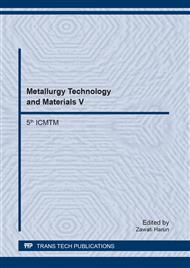p.3
p.9
p.15
p.19
p.24
p.29
p.36
p.40
p.46
Observation of Fracture Surface of Induction-Heated JIS SUJ2 Bearing Steel under Rotating Bending Fatigue
Abstract:
Martensitic high-carbon chromium bearing steel is used for rolling contact applications in various mechanical parts. Induction heating is one of heat treatment methods which take shorter time and lower energy compared with furnace heating. In the present work, we prepared induction-heated and furnace-tempered JIS SUJ2 bearing steel bar specimens. After rotating bending tests, we observed their fracture surfaces. It was found that the very large fisheye crack failures occurred and the crack size increased with increasing number of cycles to failure.
Info:
Periodical:
Pages:
24-28
Citation:
Online since:
August 2017
Authors:
Price:
Сopyright:
© 2017 Trans Tech Publications Ltd. All Rights Reserved
Share:
Citation:


